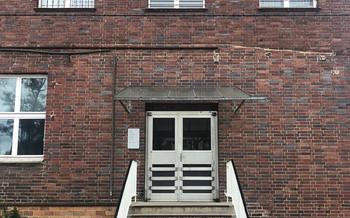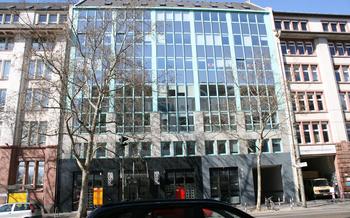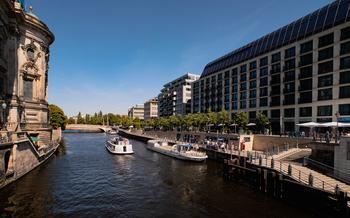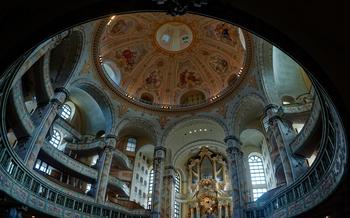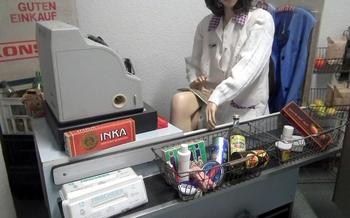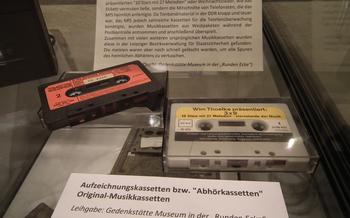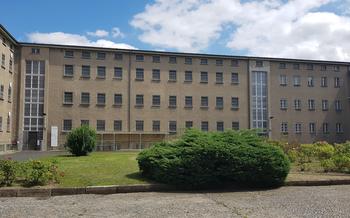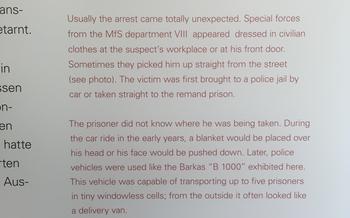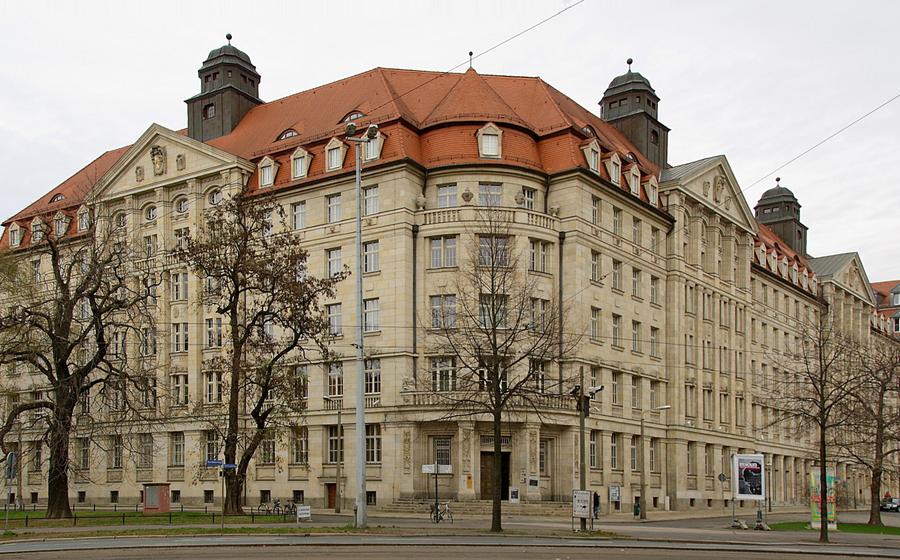
Runde Ecke Memorial Museum
- Runde Ecke Memorial Museum: Preserving Leipzig's History
- Location and Accessibility:
- Hours of Operation and Admission Fees:
- Guided Tours
- Exhibitions and Displays: Exploring the Stasi's Legacy
- Historical Importance
- Educational Value
- Personal Stories
- Indoor and Outdoor Spaces
- Documentaries and Films
- Workshops and Events
- Research Opportunities
- Gift Shop and Publications
- Insider Tip:
Runde Ecke Memorial Museum: Preserving Leipzig's History
The Runde Ecke Memorial Museum, housed in the former headquarters of the Stasi, the secret police of East Germany, is a poignant reminder of the country's oppressive past. The museum offers a comprehensive insight into the Stasi's surveillance and oppression, showcasing artifacts, documents, and personal accounts that shed light on this dark chapter in German history. Located within the very building where the Stasi once wielded its power, the museum serves as a powerful symbol of resistance and a testament to the resilience of the human spirit. Its exhibitions and displays provide a valuable opportunity to understand the impact of authoritarianism and the importance of human rights, making it an essential destination for anyone interested in the history of East Germany and the fight for freedom.
Location and Accessibility:
The Runde Ecke Memorial Museum is strategically positioned in the heart of Leipzig, at Dittrichring 24. This historic building, once the infamous headquarters of the Stasi, the secret police of East Germany, now stands as a testament to the city's resilience and transformation. Reaching the museum is a breeze, with multiple transportation options available.
For those relying on public transport, the museum is conveniently situated near several tram and bus stops. Tram lines 4, 7, and 15, as well as buses 74, 89, and 90, all stop within a short walking distance, making it easy to get there from any part of the city.
If you prefer to travel by car, the museum offers limited parking spaces on-site. However, due to the central location, finding street parking in the surrounding area might be challenging.
Disabled visitors will find the museum fully accessible, with ramps and elevators ensuring seamless movement throughout the building. The Runde Ecke Memorial Museum welcomes all visitors to delve into the captivating history of Leipzig and the Stasi era.
Hours of Operation and Admission Fees:
The Runde Ecke Memorial Museum welcomes visitors from Tuesday to Sunday, with hours varying slightly depending on the day. On Tuesdays, Thursdays, and Fridays, the museum is open from 10 am to 6 pm, while on Wednesdays it stays open until 8 pm to accommodate those with busy daytime schedules. On weekends, the museum opens from 10 am to 5 pm, allowing ample time for a leisurely exploration of its exhibits.
Admission fees for the museum are structured to ensure accessibility for all visitors. Adults can purchase a standard ticket for €6, while students and seniors can benefit from a discounted rate of €Families visiting together can take advantage of a special family ticket priced at €Additionally, the museum offers free admission to children under 6 and school groups upon prior arrangement.
To enhance your visit and delve deeper into the museum's content, guided tours are available in English and German for an additional fee of €3 per person. These guided tours are highly recommended as they provide valuable insights and historical context, bringing the exhibits to life and enriching the overall experience. Advance booking for guided tours is recommended to secure a spot, especially during peak tourist seasons.
Guided Tours
The Runde Ecke Memorial Museum offers guided tours in German and English for a more immersive and informative experience. These tours provide a deeper insight into the museum's exhibits and the history of the Stasi. The cost of a guided tour is included in the admission fee, and reservations can be made in advance or upon arrival at the museum.
The guided tours typically last for around 90 minutes and cover the museum's permanent exhibition as well as any temporary exhibitions or special displays. Visitors will learn about the Stasi's methods of surveillance and oppression, the impact of the Stasi on individuals and society, and the role of the Stasi in maintaining control in East Germany.
Taking a guided tour is highly recommended, as the guides are knowledgeable and passionate about the museum's subject matter. They can provide additional context and historical background, as well as answer any questions visitors may have. The guided tours also allow visitors to see parts of the museum that are not accessible to the general public.
Exhibitions and Displays: Exploring the Stasi's Legacy
The Runde Ecke Memorial Museum captivates visitors with its comprehensive exhibitions that delve into the Stasi's pervasive surveillance and oppressive tactics. The permanent exhibition, titled "Stasi: Power and Banality," forms the core of the museum's narrative. It showcases a vast array of artifacts, documents, and multimedia displays that illustrate the Stasi's intricate methods of control. Visitors are taken on a journey through the Stasi's history, from its establishment in 1950 to its eventual dissolution in 1990.
Temporary exhibitions and special displays complement the permanent exhibition, delving into specific aspects of the Stasi's activities or showcasing personal stories of those affected by its tyranny. These temporary exhibits offer a fresh perspective on the Stasi's legacy and encourage visitors to engage with the museum's content on a deeper level.
Among the must-see exhibits within the museum is the Stasi's surveillance technology. Visitors can marvel at the intricate listening devices, hidden cameras, and other ingenious gadgets used by the Stasi to spy on its citizens. These exhibits provide a tangible reminder of the Stasi's pervasive reach and the lengths to which it went to maintain control.
Interactive elements and hands-on experiences further enhance the museum's appeal. Visitors can try their hand at deciphering coded messages, examine Stasi files, and even sit in an authentic interrogation room. These interactive elements bring the Stasi's world to life and offer visitors a truly immersive experience.
Historical Importance
The Runde Ecke Memorial Museum serves as a crucial testament to the history of East Germany, particularly its oppressive regime and the role of the Stasi in maintaining control. The museum highlights the Stasi's pervasive surveillance and suppression of dissent, shedding light on the complexities of life under an authoritarian regime. It emphasizes the Stasi's systematic efforts to monitor and control every aspect of society, from personal communication to political activities. Through its exhibits and displays, the museum provides a deeper understanding of the impact of the Stasi on individuals and society, showcasing the human stories of those who suffered under its oppressive rule. The museum stands as a reminder of the dangers of authoritarianism and the importance of safeguarding human rights and civil liberties.
Educational Value
The Runde Ecke Memorial Museum serves as a valuable educational resource, shedding light on the complexities of the Stasi era and its impact on individuals and society. Through its exhibits, personal narratives, and historical accounts, the museum helps visitors understand the mechanisms of authoritarianism and the importance of human rights. It provides a platform for discussions and learning experiences, encouraging critical thinking and reflection on the lessons of the past. School groups and educational programs are actively encouraged, as the museum recognizes the importance of educating younger generations about the Stasi's oppressive tactics and the consequences of unchecked power. By raising awareness about this dark chapter in history, the museum contributes to a greater understanding of the dangers of totalitarianism and the enduring values of freedom and democracy.
Personal Stories
The Runde Ecke Memorial Museum breathes life into the history of the Stasi through the inclusion of personal narratives and experiences of individuals whose lives were deeply affected by this oppressive regime. Historical accounts and eyewitness testimonies paint a vivid picture of the human cost of oppression, evoking a profound emotional response in visitors. These personal stories serve as a stark reminder of the devastating impact the Stasi had on individuals and their families, humanizing the museum's exhibits and creating a deep connection with visitors on a personal level. The museum's ability to convey the human toll of authoritarianism through these poignant narratives adds a deeply moving dimension to its educational mission, ensuring that visitors leave with a profound understanding of the horrors perpetrated by the Stasi.
Indoor and Outdoor Spaces
The Runde Ecke Memorial Museum offers a combination of indoor and outdoor spaces that contribute to the overall visitor experience. The indoor exhibition spaces comprise several rooms that house the permanent and temporary displays, along with interactive elements and touchscreens. These rooms are designed to create an immersive environment, allowing visitors to delve into the history and activities of the Stasi.
In addition to the indoor spaces, the museum complex also includes outdoor areas and courtyards. These outdoor spaces provide visitors with a chance to take a break from the exhibits and reflect on their experiences. The architecture and design of the museum, both inside and out, play a significant role in enhancing the overall experience, creating a sense of authenticity and connection to the past.
The museum's accessibility considerations extend to both indoor and outdoor areas, ensuring that visitors with disabilities can navigate the spaces comfortably. Ramps, elevators, and accessible restrooms are available throughout the museum complex, allowing everyone to fully explore the exhibits and learn about this important chapter in German history.
Documentaries and Films
The Runde Ecke Memorial Museum complements its exhibits with a selection of documentaries and films that offer visitors a deeper insight into the Stasi era. These audiovisual presentations provide historical context, personal testimonies, and expert analyses, enhancing the museum's educational mission.
One must-see film is "The Lives of Others," a 2006 Academy Award-winning film set in East Germany during the 1980s. The film follows the story of a Stasi agent tasked with spying on a playwright and his actress lover. Through its compelling narrative, the film portrays the moral complexities and personal struggles faced by individuals living under surveillance.
Another notable documentary is "Citizen Four," which chronicles the story of Edward Snowden, a former NSA contractor who leaked classified information about mass surveillance programs. The film offers a contemporary perspective on the dangers of unchecked surveillance and the importance of protecting individual privacy.
These documentaries and films, along with the museum's exhibits, provide a powerful reminder of the consequences of authoritarianism and the importance of safeguarding human rights. They encourage visitors to reflect on the past and to remain vigilant in the fight against oppression and surveillance.
Workshops and Events
The Runde Ecke Memorial Museum offers a range of workshops and events that delve deeper into the history of the Stasi and its impact on East Germany. These programs provide opportunities for visitors to engage in discussions, learning experiences, and hands-on activities related to the museum's themes.
Workshops often focus on specific aspects of the Stasi's activities, such as surveillance techniques, interrogation methods, or the role of informers. Participants can learn about the Stasi's methods firsthand through interactive exercises and discussions led by experts. The museum also organizes seminars and lectures by historians, former dissidents, and other experts who share their insights on the Stasi era and its legacy.
Events at the Runde Ecke Memorial Museum include film screenings, book readings, and panel discussions. These events provide a platform for visitors to engage with the museum's content in a more interactive and dynamic way. They also offer opportunities to meet and interact with individuals who were personally affected by the Stasi or who have dedicated their lives to researching and preserving this history.
To find out about upcoming workshops and events, visitors can check the museum's website or inquire at the information desk. These programs are a valuable addition to the museum experience, allowing visitors to gain a deeper understanding of the Stasi era and its lasting impact.
Research Opportunities
The Runde Ecke Memorial Museum also serves as a valuable resource for researchers interested in delving deeper into the history of the Stasi and its impact on East Germany. The museum houses an extensive archive of documents, photographs, and other materials related to the Stasi, which are accessible to researchers upon request. The museum's staff is knowledgeable and helpful, and they can assist researchers in finding the information they need. The museum also collaborates with academic institutions on research projects and educational programs, contributing to the ongoing study and understanding of this dark chapter in German history.
Gift Shop and Publications
The Runde Ecke Memorial Museum houses a well-stocked gift shop where visitors can purchase a variety of items related to the museum's exhibitions and the history of the Stasi. From books and DVDs to souvenirs and educational materials, the gift shop offers a range of options to deepen visitors' understanding of the museum's themes.
Among the most popular items are books by former Stasi officers and dissidents, providing firsthand accounts and insights into the inner workings of the secret police. Visitors can also find a selection of DVDs and documentaries that further explore the history of the Stasi and its impact on East German society.
For those wishing to delve deeper into the museum's research, a range of publications is available, including academic journals, conference proceedings, and specialized studies. These publications provide scholars and researchers with valuable resources for their work.
Whether you're looking for a memento of your visit, a gift for a history buff, or simply want to learn more about the Stasi and its legacy, the Runde Ecke Memorial Museum's gift shop is worth exploring. Take advantage of this opportunity to support the museum's mission while enriching your understanding of this important chapter in German history.
Insider Tip:
-
For a more in-depth understanding of the Stasi's surveillance tactics, don't miss the interactive exhibit on "Surveillance Technology." This hands-on display allows visitors to operate replicas of Stasi surveillance equipment, providing a unique glimpse into the methods used to monitor and control East Germans.
-
After exploring the museum, take a break and indulge in a delicious meal at Auerbachs Keller, a historic restaurant just a short walk away. This iconic establishment has been serving traditional German cuisine since the 16th century and offers a charming ambiance to complement your museum experience.
-
To capture the essence of the museum's architecture, head to the courtyard and snap a photo of the striking contrast between the modern glass structure and the preserved remnants of the Stasi headquarters. This visually compelling image will serve as a lasting memento of your visit to the Runde Ecke Memorial Museum.
-
To fully appreciate the museum's exhibits and stories, allocate at least two to three hours for your visit. This will allow you to delve deeper into the complexities of the Stasi era, ensuring a comprehensive and meaningful experience.
